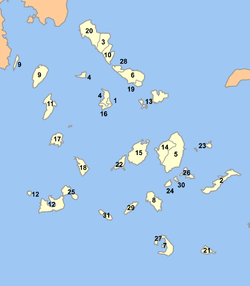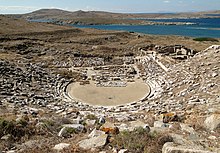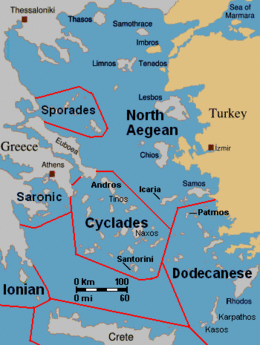Cyclades
Cyclades
Νομός Κυκλάδων | |
|---|---|
Former prefecture | |
 Location of Cyclades in Greece | |
 Location of municipalities within Cyclades Prefecture | |
| Country | Greece |
| Periphery | South Aegean |
| Established | 1833 |
| Disestablished | 2010 |
| Capital | Ermoupoli |
| Subdivisions | List |
| Area | |
• Total | 2,572 km2 (993 sq mi) |
| • Rank | 23rd |
| Population (2005) | |
• Total | 119,549 |
| • Rank | 29th |
| • Density | 46/km2 (120/sq mi) |
| • Rank | 34th |
| Postal codes | 84x xx |
| Area codes | 228x0 |
| ISO 3166 code | GR-82 |
| Vehicle registration | ΕΜ |
The Cyclades (/ˈsɪklədiːz/; Greek: Κυκλάδες, romanized: Kykládes, IPA: [ciˈkla.ðes]) are an island group in the Aegean Sea, southeast of mainland Greece and a former administrative prefecture of Greece. They are one of the island groups which constitute the Aegean archipelago. The name (Κυκλάδες νήσοι, Kykládes nísoi, 'encircling islands') refers to the archipelago forming a circle around the sacred island of Delos. The largest island of the Cyclades is Naxos, however the most populated is Syros.
History
[edit]
The significant Late Neolithic and Early Bronze Age Cycladic culture is best known for its schematic, flat sculptures carved out of the islands' pure white marble centuries before the great Middle Bronze Age Minoan civilization arose in Crete to the south. (These figures have been looted from burials to satisfy a thriving Cycladic antiquities market since the early 20th century.)
A distinctive Neolithic culture amalgamating Anatolian and mainland Greek elements arose in the western Aegean before 4000 BCE, based on emmer and wild-type barley, sheep and goats, pigs, and tuna that were apparently speared from small boats (Rutter). Excavated sites include Chalandriani, Phylakopi, Skarkos, Saliagos and Kephala (on Kea) with signs of copperworking, Each of the small Cycladic islands could support no more than a few thousand people, though Late Cycladic boat models show that fifty oarsmen could be assembled from the scattered communities (Rutter), and when the highly organized palace-culture of Crete arose, the islands faded into insignificance, with the exception of Delos, which retained its archaic reputation as a sanctuary throughout antiquity and until the emergence of Christianity.
Archaeology
[edit]
The first archaeological excavations of the 1880s, undertaken by antiquaries such as Theodore Bent at Antiparos in early 1884,[1] were followed by systematic work by the British School at Athens and by Christos Tsountas, who investigated burial sites on several islands in 1898–1899 and coined the term "Cycladic civilization". Interest lagged, and then picked up in the mid-20th century, as collectors competed for the modern-looking figures that seemed so similar to sculpture by Jean Arp or Constantin Brâncuși. Sites were looted and a brisk trade in forgeries arose. The context for many of these Cycladic figurines has been mostly destroyed and their meaning may never be completely understood.
Another intriguing and mysterious object is that of the Cycladic frying pans. More accurate archaeology has revealed the broad outlines of a farming and seafaring culture that had emigrated from Anatolia c. 5000 BCE. Early Cycladic culture evolved in three phases, between c. 3300 – 2000 BCE, when it was increasingly swamped in the rising influence of Minoan Crete. The culture of mainland Greece contemporary with Cycladic culture is known as the Helladic period.
In recent decades the Cyclades have become popular with European and other tourists, and as a result there have been problems with erosion, pollution, and water shortages.
Geography
[edit]
-
Traditional vraka (breeches) in the dress of the Aegean islands
The Cyclades includes about 220 islands, the major ones being Amorgos, Anafi, Andros, Antiparos, Delos, Ios, Kea, Kimolos, Kythnos, Milos, Mykonos, Naxos, Paros, Folegandros, Serifos, Sifnos, Sikinos, Syros, Tinos, and Thira or Santoríni. There are also many minor islands (the Lesser Cyclades) including Donousa, Eschati, Gyaros, Irakleia, Koufonisia, Makronisos, Rineia, and Schoinousa. The name "Cyclades" refers to the islands forming a circle ("circular islands") around the sacred island of Delos. Most of the smaller islands are uninhabited.
Ermoupoli on Syros is the chief town and administrative center of the former prefecture.
The islands are peaks of a submerged mountainous terrain, with the exception of two volcanic islands, Milos and Santorini. The climate is generally dry and mild, but with the exception of Naxos, the soil is not very fertile; agricultural produce includes wine, fruit, wheat, olive oil, and tobacco. Lower temperatures are registered in higher elevations and these areas do not usually see wintry weather.
The Cyclades are bounded to the south by the Sea of Crete.[2]
Administration
[edit]The Cyclades Prefecture (Greek: Νομός Κυκλάδων) was one of the prefectures of Greece. As a part of the 2011 Kallikratis government reform, the prefecture was abolished, and its territory was divided into nine regional units of the South Aegean region:
Municipalities and communities
[edit]The prefecture was subdivided into the following municipalities and communities. These have been reorganised at the 2011 Kallikratis reform as well.
| Municipality | YPES code | Seat (if different) | Postal code | Area code |
|---|---|---|---|---|
| Amorgos | 3101 | 840 08 | 22850-2 | |
| Andros (town) | 3103 | 845 00 | 22820-2 | |
| Ano Syros | 3105 | 841 00 | 22810-8 | |
| Drymalia | 3107 | Chalkeio Naxou | 843 02 | 22850 |
| Ermoupoli | 3109 | 841 00 | 22810-2 | |
| Exomvourgo | 3108 | Kampos | 842 00 | 22850-5 |
| Ios | 3112 | 840 01 | 22860-9 | |
| Kea | 3113 | Ioulis | 840 02 | 22880-2 |
| Korthio | 3115 | Ormos Korthiou | 845 02 | 22820-6 |
| Kythnos | 3117 | 840 06 | 22810-3 | |
| Milos | 3118 | 848 00 | 22870-2 | |
| Mykonos | 3119 | 846 00 | 22890-2 | |
| Naxos | 3120 | 843 00 | 22850-2 | |
| Paros | 3123 | 844 00 | 22840-2 | |
| Poseidonia | 3124 | 841 00 | 22810-4 | |
| Santorini | 3111 | 847 00 | 22860-2 | |
| Serifos | 3125 | 840 02 | 22810-5 | |
| Sifnos | 3127 | 840 03 | 22840-3 | |
| Tinos | 3129 | 842 00 | 22830-2 | |
| Ydrousa | 3130 | Gavrio | 845 01 | 22820-7 |
| Community | YPES code | Seat (if different) | Postal code | Area code |
| Anafi | 3102 | 840 09 | 22860-6 | |
| Antiparos | 3104 | 840 07 | 22840-6 | |
| Donousa | 3106 | 843 00 | 22850-5 | |
| Folegandros | 3131 | 840 11 | 22860 | |
| Irakleia | 3110 | 843 00 | 22870-7 | |
| Kimolos | 3114 | 840 04 | 22870-5 | |
| Koufonisia | 3116 | 843 00 | 22870-7 | |
| Oia | 3121 | 847 02 | 22860-7 | |
| Panormos | 3122 | 842 01 | 22830-3 | |
| Schoinousa | 3128 | 843 00 | 22870-7 | |
| Sikinos | 3126 | 840 10 | 22860-5 |
Provinces
[edit]Note: Provinces no longer hold any legal status in Greece.
Cuisine
[edit]Local specialities of the Cyclades include:
- Brantáda, cod fillet fish dish
- Fava Santorinis (made from Lathyrus clymenum)
- Fourtalia (Andros), omelette
- Kakavia (soup)
- Matsata, pasta
- Kalasouna (Naxos)
- Kalogeros (Naxos)
- Tomatokeftedes
- Various cheeses, such as Kopanisti Mykonou, Manoura Sifnou, Armexia, Malaxia, Chloro, San Michali etc
- Loutza, similar to the Cypriot lountza
- Strapatsada (Koskosela)
- Sfougato (omelette)
- Lazarakia (dessert)
- Melitinia (dessert)
- Melopita (dessert)
- Santorini (wine)
See also
[edit]Notes
[edit]- ^ Theodore Bent, ‘Researches among the Cyclades’. 1884, The Journal of Hellenic Studies, Vol. 5, 42-59.
- ^ Saundry, Peter; Hogan, C. Michael; Baum, Steve (2011). "Sea of Crete". In Pidwirny, M.; Cleveland, C. J. (eds.). Encyclopedia of Earth. Washington DC: National Council for Science and Environment.
References
[edit]- MacGillivray, J. A.; Barber, R. L. N., eds. (1984). The Prehistoric Cyclades. Edinburgh.
{{cite book}}: CS1 maint: location missing publisher (link) - Barber, R. L. N. (1987). The Cyclades in the Bronze Age. Iowa City.
{{cite book}}: CS1 maint: location missing publisher (link)
External links
[edit]- Jeremy B. Rutter, "The Prehistoric Archaeology of the Aegean": especially Lessons 2 and 4: chronology, history, bibliography
- Cyclades The Official website of the Greek National Tourism Organisation











